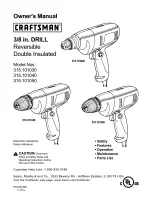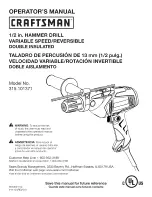
POWDP1570
EN
Copyright © 2018 VARO
P a g e
|
6
www.varo.com
metal workbench or concrete floor) at least 1 foot away from all flammable objects, such
as drapes or walls. Keep a fire extinguisher and a smoke detector in the area. Frequently
monitor the Charger and Battery Pack while charging.
▪
This product is not a toy. Keep it out of reach of children.
▪
The warnings, precautions, and instructions discussed in this instruction manual cannot
cover all possible conditions and situations that may occur. It must be understood by the
operator that common sense and caution are factors which cannot be built into this
product, but must be supplied by the operator.
▪
Make sure of your footing on ladders and scaffolding when drilling free-handed.
▪
Use a line detector to localize lines in walls with concealed electric, water or gas lines.
Avoid touching live components or conductors.
▪
Wear ear muffs to protect your hearing. Loss of hearing can be a gradual process!
▪
Wear goggles and use a dust mask on jobs generating dust.
▪
Do not use in areas where there are vapours or flammable liquids.
▪
Chisel bits and drill bits may be flung out of the machine accidentally and cause serious
injury:
▪
Before starting to work, always check that the chisel or drill bit is property locked in the
chuck.
▪
Examine the chuck regularly for signs of wear or damage.
▪
Never start up a hammer tool until it pressed against a workpiece (wall, ceiling, etc.).
▪
Protect your eyes and other workers from flying particles and splinters. Wear a helmet! Set
up partition walls!
▪
Wear work gloves to protect fingers from bruising and grazing.
▪
Vibrations can injure the hand-arm system. Keep exposure to vibrations as short as
possible.
7 ADDITIONAL SAFETY INSTRUCTIONS FOR BATTERIES AND
CHARGERS
Use only batteries and chargers applicable for this machine.
7.1
Batteries
▪
Never attempt to open for any reason.
▪
Do not store in locations where the temperature may exceed 40 °C.
▪
Charge only at ambient temperatures between 4 °C and 40 °C.
▪
Store your batteries in a cool dry place (5 °C-20 °C). Never store batteries in discharged
state.
▪
It is better for Li-ion batteries to discharge and reload them regularly (at least 4 times a
year). The ideal charge for long-term storage of your Li-ion battery is 40% of capacity.
▪
When disposing of batteries, follow the instructions given in the section “Protecting the
environment”.
▪
Do not cause short circuits. If connection is made between the positive (+) and negative (-)
terminal directly or via accidental contact with metallic objects, the battery is short circuited
and an intense current will flow causing heat generation which may lead to casing rupture
or fire.
▪
Do not heat. If batteries are heated to above 100 °C, sealing and insulating separators
and other polymer components may be damaged resulting in electrolyte leakage and/or
internal short circuiting leading to heat generation causing rupture or file. Moreover do not
dispose of the batteries in fire, explosion and/or intense burning may result.
▪
Under extreme conditions, battery leakage may occur. When you notice liquid on the
battery, proceed as follows:
Carefully wipe the liquid off using a cloth. Avoid skin contact.






























